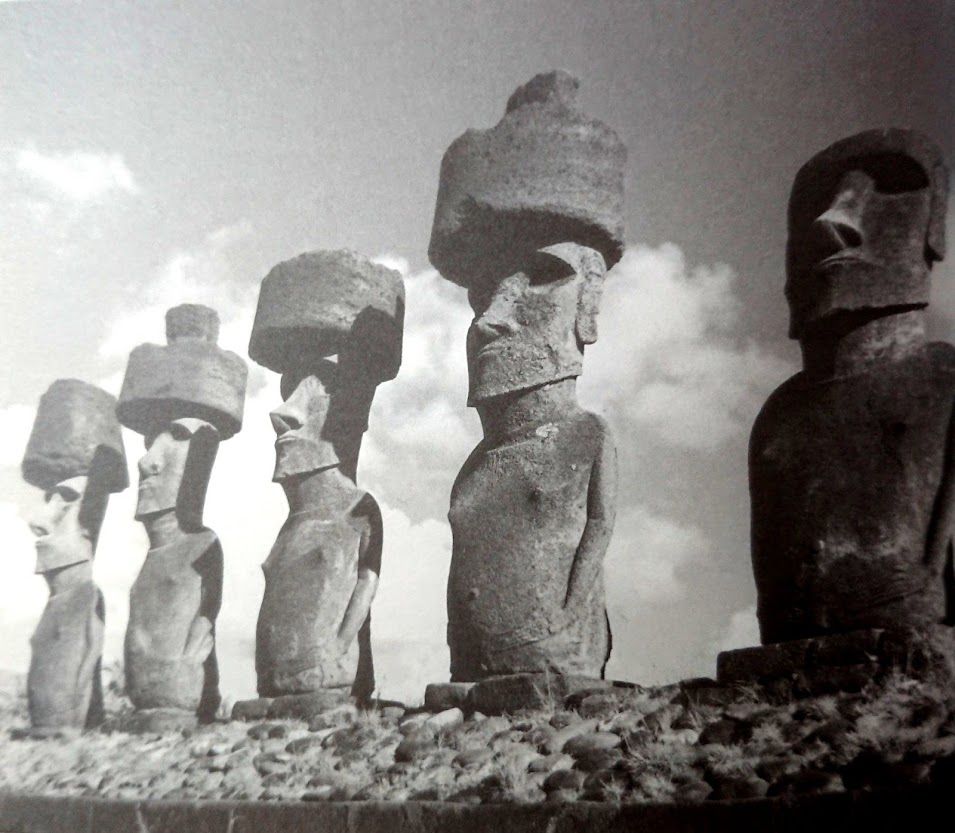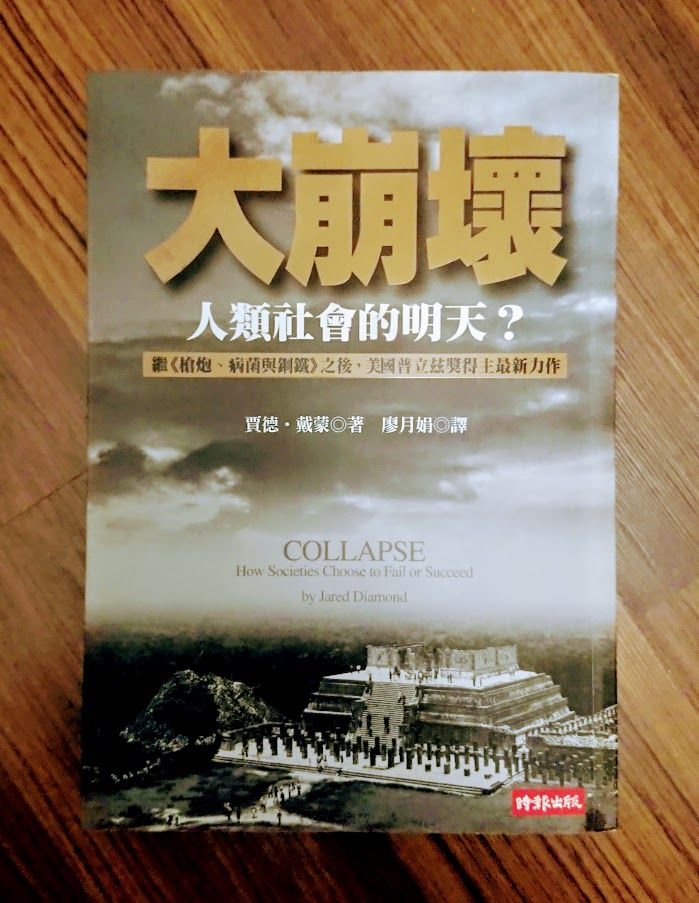
半導體外商的小小螺絲釘,遊走於廢青與社畜之間。熱愛閱讀,喜歡透過書本探索外在、內化自我。希望藉由書寫打開與世界交流的一扇窗。 個人部落格:https://maxjamesread.com/
"The Great Collapse": How did human society go to collapse? Environmental protection is the key!

In the past, people have established many magnificent civilizations, such as the Maya and the Polynesian culture of Easter Island. But they died quickly after their peak, which is puzzling. "The Great Collapse" gives a warning answer to this question: Human beings destroy the environment, and ultimately suffer the consequences and lose their survival niche.
This book is Judd. The second installment of Damon 's "The Great History of Humanity" trilogy. The first episode was previously introduced: Guns, Germs, and Steel . In this book, he once again used his profound knowledge, spanning the world, across the past and the present, with a large number of cases and scientific and sociological research, to bring readers a turbulent historical journey.
Judd. Dimon uses this book to tell everyone that environmental protection is not an idealistic pursuit, but an important matter that is directly related to us. If we ignore environmental damage and develop on our own, in the end, we will be backlashed.
While I love New Guinea birds, I love my son, my wife, my friends, New Guineans, and more. I am very concerned about the problem of environmental damage, because I know that the impact of this problem on human society is even worse.
- Judd. Dimon
This insight will start with the top 5 reasons why civilizations are collapsing, explaining why environmental issues are so important; then I'll go into detail about Easter and how Greenlandic society is dying; then I'll explore why humans are blind to obvious environmental problems; Two possible solutions will be proposed.
[5 main reasons for the collapse of civilization]
First, let's talk about the five reasons that lead to the collapse of human society.
[1. Destruction of the ecological environment]
The first is environmental damage, which is the subject of this book. Judd. Dimon pointed out that the collapse of many civilizations in the past actually followed similar footsteps:
- a
As civilization progresses, the population increases day by day. - Environmental Destruction <br class="smart">Population pressure turns residents to intensive farming and overgrazing, paying the price of environmental damage to feed the population.
- resource exhaustion
Continued reclamation led to depletion of land and hunting resources, and food shortages began to emerge. - war conflict
In order to compete for limited resources, people clashed constantly, and even rose up to overthrow the elite government. - perish
In the endless struggle, the civilization that was once at its peak can only go to the end.
And all this is like the constant variation of the same theme, which has been continuously performed in the vast history of mankind.
[2. Climate change]
Another reason is climate change. In addition to the global warming that everyone is familiar with today, the natural climate itself will actually change over time. Hotter, colder, drier, and wetter are all possible directions.
Climate change can be a blessing or a curse. If it happens to go in the wrong direction, a civilization is naturally at risk. For example, the Little Ice Age from 1400 to 1800, or the dry western United States in recent years.
Of course, natural climate change is beyond human control. But a socially exploitative environment makes living conditions vulnerable. At this time, if it happens to hit the black swan of climate change, it is more likely to be shot down.
[3. Strong Neighbor Threat]
I believe this is not difficult for everyone to understand. The natural survival of a civilization is of course threatened if there is a hostile neighbor nearby.
But Judd. Dimon also pointed out that if a civilization is strong enough, there may still be a possibility of confrontation; on the contrary, if the environment is destroyed and its constitution is weakened, it will give the enemy an opportunity to take advantage.
[4. AIA support has weakened]
There are enemies and there are friends. Societies in ancient and modern times will mostly trade with the civilizations around them. If there is a problem with the partners around you and cannot continue to supply important materials, the prospects are naturally worrying.
The book cites as examples Mangareva, Pitken and Henderson, three neighboring islands that were once closely traded. Mangareva is declining due to the ecological catastrophe, causing Pitken and Henderson, who originally relied on their materials, to be unable to return to the sky and become deserted islands even if they tried hard to seek life.
Judd. Dimon pointed out sharply that the economic dependence of today's world due to globalization is actually like a replica of these small islands, or even more serious. I believe that everyone can understand the vulnerability of such interdependence since the pneumonia.
[5. The ability to adapt to problems]
The last item is the resilience of civilization when it encounters problems. Although many problems are irresistible factors (such as sudden changes in the climate), if timely responses can often be turned around, if they are unwilling to change, then death is difficult to avoid. This will be explained in more detail later in the Greenland and Japan examples.
From the above, it can be found that a civilization will be destroyed, although the reasons are intricate and complicated, but the environment often plays an indispensable factor. The book lists 12 modes of environmental damage. The first 8 are common environmental damages in human society in the past, while today’s society has the following 4 more:
past society
- deforestation
- soil problem
- water management issues
- overgrazing
- overfishing
- introduction of new species
- a
- Ecological shock per capita
Now the society is adding
- anthropogenic climate change
- deposition of toxic substances
- energy shortage
- photosynthesis limit
After talking about the five reasons for the collapse of civilization, I want to use the two painful cases of society in the book to let you feel more specifically why environmental damage will lead to the collapse of civilization.
【2 tragic cases】
[1. Easter]
When thinking of Easter Island, the first impression of ordinary people should be those mysterious megaliths.

The ability to carve, move, and erect these boulders required a complex, populous, and affluent society. But when explorers discovered Easter Island, it was a barren land, lacking wildlife and sparsely populated, and simply couldn't afford to build these megalithic statues. Apparently Easter Island was not like that in the past.

In fact, Easter Island used to be huge and green. Archaeologists have found that the deforestation problem on Easter Island has become increasingly serious after the arrival of humans (about 900 AD). By 1722, the island's forests were nearly deforested.
The consequences of a lack of trees are fatal. Not only has wildlife been decimated by the loss of habitat, but soil has also become more vulnerable to rain erosion, which has taken a toll on crop yields. In addition, the islanders who lacked wood lost the opportunity to make canoes and go to sea, and the food they could enjoy at sea in the past can only be reduced to fantasy.
From the above situation, archaeologists deduce the process of Easter Island's decline. With a lot of land reclamation, the population is booming. Although civilization flourished and even had the ability to build megalithic statues, due to the excessive destruction of the environment, resources were exhausted, and famine followed. Then people fought for resources and went to war, and even the tragic situation of cannibalism occurred, and finally went to extinction.
The tragic case of Fujie Island shows us what the consequences will be if a society overuses resources. Because the islanders have little connection with the nearby society, and no evidence of climate change has been found, it is almost certain that the collapse of Easter Island was caused by environmental damage.
[2. Greenland]
Ninety-nine percent of Greenland's land is uninhabitable white snow or black hills. Its English name Greenland, it seems a bit strange. Yes, it wasn't like this from the beginning either. In the 10th century, the Vikings opened up territory and established a mature human civilization. However, they became extinct after 400 years.
The reason might feel a little familiar to you. When the Vikings came to Greenland, they began to cut down trees, cut sod and overgraze, causing soil erosion. Like Easter Island, the resulting shortage of wood prevented them from building ships and lost access to sea resources. In addition, this also resulted in a lack of firewood for the Vikings, which was deadly in icy Greenland.
Of course, Greenland itself is in poor condition. The climate is cold, the growing season is short, and it is difficult to grow anything. It was extremely difficult for the Vikings to survive here. When the weather is bad, you will be stretched thin. It is almost conceivable that in a particularly severe winter, the Vikings finally could not wait for the spring, ran out of food, and went to the end.
But the harsh environment does not explain why the Vikings went extinct, because in addition to them, there are Inuit people . So what caused the Vikings to go extinct and the Inuit to survive?
One reason is worth thinking about: the Vikings' idea of European identity.
Greenlanders consider themselves Christians. Even though their resources are already scarce, they still build churches of all sizes, such as St. Nicholas Church, which is a behemoth with a length of 32 meters and a width of 16 meters. In addition, they also advocate the European style of life. This can be known from imported candle holders and glass buttons.
Such beliefs and national identity allow them to struggle to survive in harsh environments. But it also made them view the Inuit as aliens and reluctant to learn from them.
For example, the same lack of wood, the Inuit people know how to build houses with snow blocks, use blubber for lighting, and even develop small kayaks covered with sealskins on the brackets. But the Vikings did not imitate their neighbors, and finally disappeared completely from the land.
Greenland is a good example of how a society's ability to adapt to adversity is closely related to its ability to survive.

After talking about the above two examples of the demise of human society. If we turn the camera back to the present, we will find that the situation is not optimistic.
For example, Montana in the United States is also facing problems such as excessive logging, soil salinization, water shortage, etc., and even more mining pollution, which is a disease that only exists in today's society.

Another example is China, which is next to us. In addition to the basic deforestation and overgrazing, its air pollution problem is even more serious, which leads to water pollution. Coupled with the rapid economic development in recent years, the per capita living standards have risen, and the damage to the environment has become more severe.
Of course, these societies are still a long way from collapse, but many civilizations in the past flourished for a while, but then plummeted after their peak. Although the above-mentioned Greenland was finally wiped out, they also lasted for more than 400 years, much longer than many of the countries we are familiar with today.
[Why did human beings come to collapse? 】
Seeing this, I wonder if you will have a question. Since the environmental damage is so catastrophic, why do many civilizations still ignore these problems and go to the end? Like the people on Easter Island, they know that trees are the root of their survival, why do they still cut them down?
On this issue, Judd. Dimon spends a lot of time in the book discussing it. Here I would like to cite two reasons that I think are important:
[1. Tragedy of the Commons]
The tragedy of the commons refers to the fact that many people are using a common resource, such as fishermen fishing in a certain sea area, and shepherds grazing on common pastures. If everyone overuses, this common resource will be exhausted. In the end everyone suffers.
In theory, everyone should exercise restraint and make resources sustainable, but people often think: "If I don't use more, other people will too, so I can't suffer." Such thinking will make the situation of overuse unstoppable, and eventually cause resource exhaustion.
[2. Conflict between short-term and long-term motivation]
Another very important reason is the conflict of short- and long-term interests.
In the short term, environmental conservation often conflicts with current economic interests, and benefits can only be seen if the time is extended. But as Keynes said, in the long run, we are all dead . So many people, and even companies, are reluctant to think that far.
If an environmental issue affects our grandchildren's livelihood, everyone may care. But what if it would affect the grandson of the grandson? Most people choose to ignore it.
【Solution? 】
At this point, everyone should be able to feel the importance of environmental conservation. Is there a possible solution to these dilemmas?
Faced with this problem Judd. Dimon proposed two solutions: top- down and bottom -up:
[top down]
One of the methods starts from the government and implements executive orders from the top to improve the environment.
Such as the example of the Japanese shogunate government planting trees in the book. Japan is a very wood-loving nation. Many buildings are made of wood. At the same time, they also use wood as fuel. In order to cope with population growth, it is also necessary to clear forest land for farming. In this way, Japan seems to be going in the footsteps of Easter Island.
But they didn't.
After the Great Fire of Edo in 1657, the shogunate was alarmed by a shortage of wood due to the large amount of wood required for reconstruction. Over the next two centuries, they began to implement a series of vigorous policies. In addition to strictly prohibiting people from cutting trees privately, they are also actively planting trees, and even strictly monitoring the forest conditions (the forest account book below), and finally successfully survived the crisis. So far, Japan's forest resources are quite rich.

(bottom up)
In addition to top-down enforcement, another very important way is to create a more sustainable environment from the bottom up, starting from everyone.
For example, the book mentions that small people like us can put pressure on companies that cause environmental damage. Judd. Dimon believes that company owners prioritize "shareholders' creation of interests", and they cannot be expected to do a good job of environmental protection voluntarily. People must create pressure for companies to change their behavior by boycotting related products.
Certain industries are harder to boycott outright, and we can put pressure on companies that source their raw materials. As the book mentions, instead of protesting gold mining pollution, it is better to put pressure on jewelry companies.
Another point is that everyone should be willing to pay for environmental protection and support more environmentally friendly businesses and products. As mentioned in the book, it is possible to purchase FSC (Forestry Stewardship Council) certified products to ensure that their logging procedures meet sustainable standards.
Of course, top-down and bottom-up are not two parallel lines. Only when the two sides spread out and work together, can a sustainable environment be created.
【Summarize】
Come to summary time. To sum up, a society will collapse, often because the population grows, more resources need to be consumed to support the family, and finally the environment will be overloaded and be eaten back. Even if it can survive, if the weather is bad or a strong enemy invades, it will eventually die.
From this perspective, the situation we are in is actually not optimistic. The global population has surpassed the 7 billion mark, coupled with rapid economic development, environmental damage has become more diverse. And globalization ties the world together, and the disintegration of a society often extends to the world.
However, the mutually exclusive nature of the tragedy of the commons and long-term and short-term goals often makes people fail to pay attention to environmental protection. Only through the joint efforts of the government and the people from the bottom to the top can we overcome these difficulties and think about the value of environmental sustainability from a longer-term perspective.
【Postscript: People, people】
This book is the first book I plan to reread in 2022. I took the opportunity to buy the new edition for the 15th anniversary, and it was very enjoyable to read. The old book cover is also attached here, and the gray is also quite flavorful.

I think the discussion of population in the book is very interesting, and I want to talk about it again. After all, a civilization will need to continue to destroy the environment, nothing more than to support population growth. The book mentions that many human societies have the practice of abortion and infanticide in order to control the population. Judd. Dimon even took a positive view of China's one-child policy, arguing that population stagnation is a good thing.
Yet even China has recently abandoned its one-child policy due to labor pressures. Taiwan's low fertility rate is often seen as a national security crisis. So it seems to be a dead end. We need more people to work to support the economy, but more people means more environmental damage.
It suddenly occurred to me that I have often heard recently that people will be replaced by AI. If you can achieve higher productivity with fewer people, maybe that's not all bad?
I also don't have an answer to these. What we can do now is to start from ourselves and pay attention to environmental protection.
As the book emphasizes, environmental protection and economics are not mutually exclusive. For example, the damage caused by mining pollution will ultimately cost more money to deal with. To make matters worse, many damages are irreversible. After all, the earth's resources are limited, and continuous consumption will only make future people suffer the bitter consequences.
In the long run, we are all dead. But I hope our children and grandchildren can still live well!
Articles you may also be interested in:

↓↓You are also welcome to follow the Facebook and mourning of "Mrs's Reading Space"↓↓
James' reading space FB
James' reading space IG
Like my work?
Don't forget to support or like, so I know you are with me..
Comment…